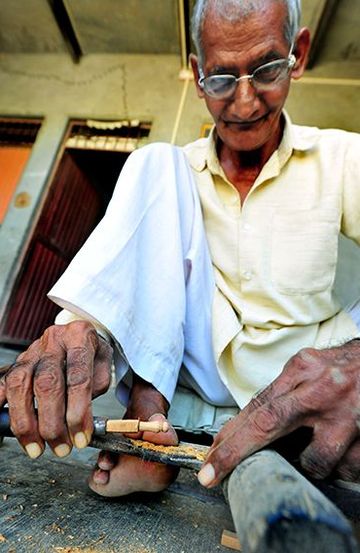As you pass through the dusty lanes of Mangali, a little-known village 12km ahead of Hisar in Haryana, you are unlikely to see groups of villagers whiling away their time around the hookah―a sight common elsewhere in the state. What you will see instead are people making rosary beads. The village is one of the biggest producers of rosary beads, with exports to Saudi Arabia, Iraq, Iran, France, the UK and the US. And for almost every resident of the village, be it a 15-year-old boy or an 80-year-old man, the beads are an answer to their prayers of survival and self-reliance.
 Chabil Das, 66, is the only person in his village who uses conventional tools for making beads.
Chabil Das, 66, is the only person in his village who uses conventional tools for making beads.
“In 1923, one of our great grandfathers who was a khati [carpenter] went to his maternal uncle's village in Gurgaon district and learnt the art of making sandalwood beads. He came back and taught it to others. Thus began a modest movement that changed our fate,” says Chabil Das, 66, who is the only one in the village to still use a hand-operated drilling machine. There are hundreds of bead-making units in the village, which produce three lakh strings―each made of 108 beads―a day.
Unlike other traditional arts, youngsters are keen on learning the process and taking the business forward. “Just like many of my age, I inherited the art from my father and took over the unit,” says Anil Kumar, 28. “These beads are our lifeline.” The beads produced here are increasingly being used in jewellery and accessories. With sandalwood prices going through the roof, beads of cheaper material like redwood, sheesham and ber wood are preferred. “However, beads meant for export are still made from sandalwood,” says Kumar.
And bead production is a family affair. There are 250 members in Das's family, all of whom are in this profession. “We do not get any labourers from outside,” says Kumar's mother, Rajbala. “Everybody chips in whenever he or she is free. The young boys work on the drill. The aged and the women help thread the beads. Even toddlers are not spared. They can always collect the waste from under the drills. If we have more work, we employ local lads or artisans who freelance. It is a cooperative effort in more ways than one.”
While it is a flourishing business, with family incomes ranging from Rs20,000 to Rs45,000 per month, villagers still have to deal with government apathy. Despite repeated promises, the Haryana government has not yet considered exporting beads through the state import-export corporation, leaving the artisans at the mercy of private export houses. Similarly, repeated requests to set up a wood depot in Hisar have fallen on deaf ears, forcing artisans to buy wood from traders, and in many cases, getting stuck in a smuggling tangle.






